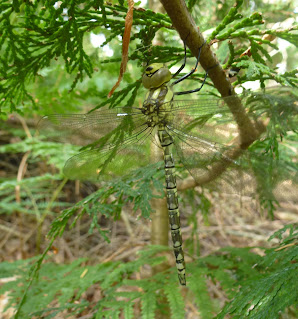A select group of four Honeyguiders met at Lady Anne’s Drive on the Holkham estate on a warm and sunny July morning. Our target for the day was creeping lady's tresses, a diminutive white orchid which is scarce but widespread in the native pine forests of Scotland but with an odd out-lying population at Holkham in the pine woodlands that were planted to stabilise the sand dunes in the 19th century. The origin of the Holkham population is uncertain - some think they might have been inadvertently introduced on trees planted in the dunes that had been grown further north. We will never know for sure.
 |
| 'Gatekeeper among thousands' (Jillian Macready). |
 |
| Hoverfly Eristalis pertinax (Rob Lucking). |
 |
| Robber fly sp (RL). |
 |
| Ant-lion pits among the brickwork (JM). |
As we neared the end of the pine woods, we cut through towards the beach to the area of dunes where the creeping lady's tresses are found. Some forestry work had been carried out along the track and the more open areas had quite a lot of ragwort growing which in turn held caterpillars of the cinnabar moth. We also found several plants of lesser centaury. As the woodland opened out onto the dunes, we found that the creeping lady's tresses area had been roped off and within it we found at least eight spikes - some tightly closed and the others fully open.
 |
| Creeping lady's tresses (JM). |
 |
| Megachile leachella, male on fleabane (JM). |
Two bees photographed by Jillian, with IDs confirmed later, are of note. Silvery leafcutter bee, Megachile leachella, is the UK’s smallest leafcutter bee; the green tinge to the eyes is a feature. The BWARS website shows a coastal distribution for this species.
 |
| Heriades truncorum, female, also on fleabane (JM). |
Heriades truncorum is also scarce (see BWARS website), though spreading, and is often - though not always - associated with pines, using resin to build partitions of its nest, liking dead timber with suitable-sized beetle holes, in the sun and with yellow composites, often ragwort but today fleabane.
At this point Jillian departed for Warham Camp and the rest of the group had lunch looking out over the beach. It was the section of beach frequented by naturists so we didn’t look too closely!
After lunch we walked west through the dune slacks looking for a butterfly speciality – the dark green fritillary. It didn’t take Helen long to find the first one - a rather worn specimen but it did at least sit still for long enough for us to give it good grilling and we even saw the dark green underwing for which it is named.
As we wandered through the dunes, we found several more dark green fritillaries and also watched an emperor dragonfly catch a peacock butterfly in flight and take it down to the ground to eat.The dunes themselves were very parched but we did find some common centaury and lots of haresfoot clover.
 |
| Common centaury (JM). |
We retraced our steps back towards the car park. There were a lot of very fresh and brightly coloured ruddy darters sunning themselves on the track. We also found a couple of new butterflies for the day – brown argus and small copper. We stopped and lingered next to a stand of elms which have proved good in the past for white-letter hairstreak but it was getting a bit late in the day; the breeze had picked up and we drew a blank. A large, pale brown insect flew past quickly and did several circuits – not a butterfly but an oak eggar moth!
Jillian reported a successful visit to Warham Camp where she had seen chalkhill blue butterflies which added to the 15 species we recorded at Holkham gives us a very respectable 16 species overall!
 |
| Chalkhill blues at Warham Camp (photos by JM). |
Rob Lucking








.jpg)








